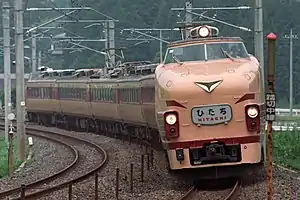211 series
The 211 series (211系, 211-kei) is a suburban electric multiple unit (EMU) train type introduced in 1985 by the Japanese National Railways (JNR). It is operated by East Japan Railway Company (JR East) and Central Japan Railway Company (JR Central). It was formerly operated by West Japan Railway Company (JR-West) in Japan.
| 211 series | |
|---|---|
 JR East 211 series set on a Joetsu Line service in January 2021 | |
| Manufacturer | Hitachi, Kawasaki Heavy Industries, Kinki Sharyo, Nippon Sharyo, Tokyu Car Corporation |
| Replaced | 111 series, 113 series, 115 series |
| Constructed | 1985–1991 |
| Entered service | March 1986 |
| Scrapped | 2012– |
| Number built | 1,914 vehicles |
| Number in service | 849 vehicles (as of 2018) |
| Successor | 209 series, E233-3000 series, 315 series (from 2025) |
| Operator(s) |
|
| Specifications | |
| Car body construction | Stainless steel Steel (JR West version) |
| Car length | 20,000 mm (65 ft 7 in) |
| Width | 2,966 mm (9 ft 8.8 in) |
| Doors | 3 pairs per side |
| Maximum speed |
|
| Traction system | Resistor control + field system superimposed field excitation control |
| Traction motors |
|
| Power output | 120 kW |
| Acceleration | 1.7 km/(h⋅s) (1.1 mph/s) |
| Electric system(s) | 1,500 V DC overhead catenary |
| Current collector(s) | Pantograph |
| Bogies |
|
| Multiple working | 311/313 series |
| Track gauge | 1,067 mm (3 ft 6 in) |
Design
The 211 series was developed by JNR to replace older 113 series and 115 series trains. The 211 series incorporated regenerative brakes and stainless steel body construction.
Variants
- 211-0 series (basic version with transverse seating)
- 211-1000 series (cold region version with transverse seating)
- 211-2000 series (basic version with all longitudinal seating)
- 211-3000 series (cold region version with all longitudinal seating)
- 211-5000 series (JR Central version)
- 211-6000 series (JR Central version with single motored car)
- Joyful Train variants (JR West version)
Operations
211-0, 211-2000 series
- Tōkaidō Main Line and Ito Line: Tokyo – Numazu/Ito (From 1986 - April 2012)
- Tōkaidō Main Line: Hamamatsu – Maibara
- Chūō Main Line: Tachikawa – Shiojiri
- Shinonoi Line: Shiojiri – Shinonoi
- Shinetsu Line: Shinonoi – Nagano
 211-0 series in original JNR livery in August 1988
211-0 series in original JNR livery in August 1988 211-0 series in JR livery in December 2009
211-0 series in JR livery in December 2009 211-0 series interior view, February 2010
211-0 series interior view, February 2010 211-2000 series interior view, November 2021
211-2000 series interior view, November 2021 Green car seating, July 2010
Green car seating, July 2010
211-1000, 211-3000 series
- Tohoku Main Line: Oyama – Utsunomiya[1]
- Takasaki Line: Ueno - Takasaki (1986 - March 2014)
- Ryomo Line: Takasaki – Oyama
- Shinetsu Line: Takasaki – Yokokawa
- Oito Line: Matsumoto –Shinano-Omachi
- Chuo Main Line: Tachikawa – Shiojiri/Shiojiri – Nakatsugawa
- Shinonoi Line: Shiojiri – Shinonoi
- Shinetsu Main Line: Shinonoi – Nagano
- Sobu Main Line: Chiba – Chōshi (via Yachimata) (21 October 2006 – 2012)[2]
- Narita Line: Chiba – Chōshi (via Narita) (21 October 2006 – 2012)[2]
- Kashima Line: Sawara – Kashima-Jingu (21 October 2006 – 2012)[2]
- Togane Line (since 21 October 2006 – 2012)[2]
- Uchibo Line: Chiba – Awa-Kamogawa (via Kisarazu) (21 October 2006 – 2012)[2]
- Sotobo Line: Chiba – Awa-Kamogawa (via Katsuura) (21 October 2006 – 2012)[2]
- Iida Line (since 15 March 2014)[3]
- Agatsuma Line (since 22 August 2016)[1]
- Joetsu Line: Takasaki - Minakami (since 23 August 2016)[1]
 211-3000 series with additional pantograph in March 2022
211-3000 series with additional pantograph in March 2022 211-3000 series in Nagano area livery in January 2022
211-3000 series in Nagano area livery in January 2022 211-3000 series in Chiba area livery in May 2010
211-3000 series in Chiba area livery in May 2010 211-3000 series interior view, February 2022
211-3000 series interior view, February 2022 Priority seats, February 2022
Priority seats, February 2022
211-5000, 211-6000 series
- Tokaido Main Line: Atami – Toyohashi
- Chuo Main Line: Nagoya – Nakatsugawa
- Kansai Main Line: Nagoya – Kameyama
- Gotemba Line: Kōzu – Numazu
- Minobu Line: Fuji – Nishi-Fujinomiya
- Aichi Loop Line: Kozoji – Setoguchi
 211-5000 series in December 2019
211-5000 series in December 2019 211-5000 series interior view, September 2021
211-5000 series interior view, September 2021 Priority seats, September 2021
Priority seats, September 2021
Joyful Train sets
- Super Saloon Yumeji: Three-car set converted from 211 and 213 series coaches which entered service in 1988 and withdrawn in March 2010. Operated by JR-West and based at Okayama Depot.
 Joyful Train 211 series in JR-West Livery in January 1989
Joyful Train 211 series in JR-West Livery in January 1989 Iinterior view, September 2003
Iinterior view, September 2003
See also
References
- 上越線・吾妻線で211系の営業運転開始 [211 series enter service on Joetsu Line and Agatsuma Line]. Japan Railfan Magazine Online (in Japanese). Japan: Koyusha Co., Ltd. 24 August 2016. Retrieved 27 August 2016.
- "10/21, 房総211系, 営業運転開始" [Boso 211 series enter service]. Japan Railfan Magazine (in Japanese). 47 (549): 179. January 2007.
- 飯田線での長野色115系運用終了,211系運用開始 [Nagano-livery 115 series withdrawn from Iida Line; 211 series introduced]. Japan Railfan Magazine Online (in Japanese). Japan: Koyusha Co., Ltd. 15 March 2014. Retrieved 15 March 2014.
External links
Wikimedia Commons has media related to JNR 211.
- JR East 211 series (in Japanese)
- JR Central 211 series information (in Japanese)
This article is issued from Wikipedia. The text is licensed under Creative Commons - Attribution - Sharealike. Additional terms may apply for the media files.

